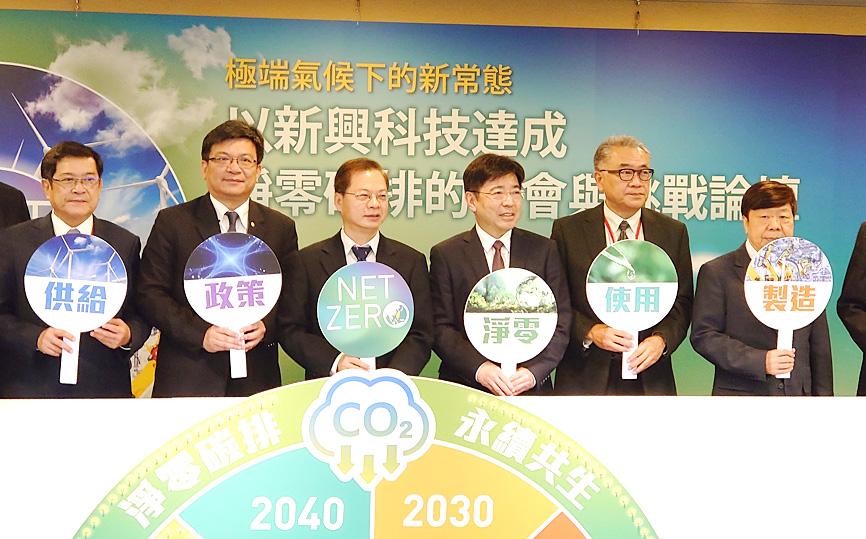The mothballed Fourth Nuclear Power Plant in New Taipei City’s Gongliao District (貢寮) is “outdated technology,” Deputy Minister of Economic Affairs Tseng Wen-sheng (曾文生) said yesterday.
“We cannot solve the problems we will face 10 years from now with technology that is already two decades old,” Tseng told a clean energy forum organized by the Industrial Technology Research Institute (工研院).
With nuclear energy off the table as an option, Tseng proposed other solutions to reduce carbon emissions.

Photo: CNA
“We hope that more commercial enterprises will join Taiwan Power Co (台電) in developing the green energy market,” Tseng said. “We will liberalize the market more so that the private sector can help reduce our carbon footprint.”
He also named reducing carbon emissions during the manufacturing process, promoting electric vehicles and carbon capture technologies as ways for Taiwan to reduce its carbon output.
The nation is on Aug. 28 to hold a referendum on whether to activate the nuclear power plant.
President Tsai Ing-wen (蔡英文) last month said that activating the plant would be both expensive and dangerous, and “absolutely not an option.”
Tsai’s energy transition plan looks to raise the proportion of liquified natural gas in the nation’s energy mix to 50 percent, while renewable energy would make up 20 percent, and nuclear power would have nearly zero contribution by 2025.
Nuclear power advocate Huang Shih-hsiu (黃士修), who initiated the referendum drive, said Tseng was wrong to describe the nuclear power plant as “outdated technology.”
“There are more than 90 nuclear reactors whose tenure has been expanded to 60 years in the US, some are planned to continue generating power for 80 or even 100 years,” Huang said. “Compared with those plants, the Fourth Nuclear Power Plant is very advanced.”
Huang voiced confidence that his referendum would pass on Aug. 28, saying nuclear power is a comparatively cheap source of energy that would also help Taiwan reduce carbon emissions.
He described an activation of the nuclear power plant as “the first key” to solving Taiwan’s looming power shortage, saying that it can start generating electricity in five years and provide about 10 percent of the nation’s energy mix.

CHIP RACE: Three years of overbroad export controls drove foreign competitors to pursue their own AI chips, and ‘cost US taxpayers billions of dollars,’ Nvidia said China has figured out the US strategy for allowing it to buy Nvidia Corp’s H200s and is rejecting the artificial intelligence (AI) chip in favor of domestically developed semiconductors, White House AI adviser David Sacks said, citing news reports. US President Donald Trump on Monday said that he would allow shipments of Nvidia’s H200 chips to China, part of an administration effort backed by Sacks to challenge Chinese tech champions such as Huawei Technologies Co (華為) by bringing US competition to their home market. On Friday, Sacks signaled that he was uncertain about whether that approach would work. “They’re rejecting our chips,” Sacks

NATIONAL SECURITY: Intel’s testing of ACM tools despite US government control ‘highlights egregious gaps in US technology protection policies,’ a former official said Chipmaker Intel Corp has tested chipmaking tools this year from a toolmaker with deep roots in China and two overseas units that were targeted by US sanctions, according to two sources with direct knowledge of the matter. Intel, which fended off calls for its CEO’s resignation from US President Donald Trump in August over his alleged ties to China, got the tools from ACM Research Inc, a Fremont, California-based producer of chipmaking equipment. Two of ACM’s units, based in Shanghai and South Korea, were among a number of firms barred last year from receiving US technology over claims they have

It is challenging to build infrastructure in much of Europe. Constrained budgets and polarized politics tend to undermine long-term projects, forcing officials to react to emergencies rather than plan for the future. Not in Austria. Today, the country is to officially open its Koralmbahn tunnel, the 5.9 billion euro (US$6.9 billion) centerpiece of a groundbreaking new railway that will eventually run from Poland’s Baltic coast to the Adriatic Sea, transforming travel within Austria and positioning the Alpine nation at the forefront of logistics in Europe. “It is Austria’s biggest socio-economic experiment in over a century,” said Eric Kirschner, an economist at Graz-based Joanneum

BUBBLE? Only a handful of companies are seeing rapid revenue growth and higher valuations, and it is not enough to call the AI trend a transformation, an analyst said Artificial intelligence (AI) is entering a more challenging phase next year as companies move beyond experimentation and begin demanding clear financial returns from a technology that has delivered big gains to only a small group of early adopters, PricewaterhouseCoopers (PwC) Taiwan said yesterday. Most organizations have been able to justify AI investments through cost recovery or modest efficiency gains, but few have achieved meaningful revenue growth or long-term competitive advantage, the consultancy said in its 2026 AI Business Predictions report. This growing performance gap is forcing executives to reconsider how AI is deployed across their organizations, it said. “Many companies